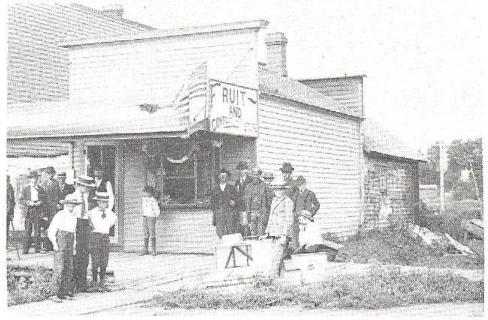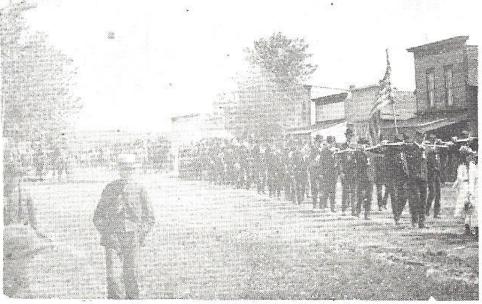It is only after a lapse of nearly forty years that I fully realize that many of the conditions then existant were not at all commonplace but simply extraordinary, so entirely the transient phases of an irresistable world movement that their like will never again be witnessed in Murray — or perhaps in the world. For instance old Main Street will never again see the endless caravans of "prairie schooners" with "Kansas (or somewhere) or bust" emblazoned on their white canopies. It will never again see marching bands of Fox, Sac and other native Indians exiled, by government edict, to the Indian Territory that their ancient and beloved hunting grounds might be converted to the uses of the on rushing pale faces. These Indians used to enter Murray from the east by Main Street, halt near the Old Sargent livery barn while the braves visited the few stores for supplies, the squaws watered the ponies and the young bucks won dimes and nickles by their skill with bow and arrow. They would again take up what must have been the heartbreaking trail, - a picturesque and, a - I now view it, a pathetic example of civilization's certain supremancy over savagery. Railroad construction work readied Murray in 1868. It was originally intended that this should be a division point of the line and not only the platters but other smaller speculators in the towns really were "stung" when the division site was changed to where now stands the city of Creston. The present generation, accustomed to the perfected railroad service of today would smile at the railroading of 1870. The road bed was unballasted and rough, the rails were of light iron that easily split and broke; the cars were
quaint little contraptions and the time
schedules between Murray and Chicago were twice as long as today. We "old" people recall with amusement the fuss and bluster of a passenger train coming to a stand still at the station. Air appliance was unknown and all hands had to get busy when a stop was due; the engineer with the clumsy, churning steam brakes and the conductor and brakemen at the hand brakes. But the locomotives were things of beauty and joy forever! True, they were not much larger than a threshing engine, but they were certainly the products of men who were not only mechanics but artists. Their wide flaring smoke stack did give them an odd appearance but this feature was overshadowed in the prodigality of their ornamentation. Where ever bands or plates of brass could be placed they were so placed and the chief function of the fireman was to keep them burnished and bright. The drive wheel and other parts were trimmed in red or other brillant colors. Each locomotive was named instead of numbered. One of them that made regular trips through Murray was named the General Grant and another was the Abraham Lincoln. |
A birdseye view of Murray in 1870 would It was a quiet and lonely little settlement, the soul of human activity being less noticeable than the calling of the prairie cocks, the bob white or the monotonous chorousing of the frogs. Great flocks of wild fowl winged fearlessly across the sky and scores of hawks and other broad winged birds soared above it. The nights were often lured from the prairie fires that sometimes approached alarmingly near. Sidewalks were almost unknown, which perhaps accounted for the bogue of wearing trousers tucked into high topped cowhide boots. There was no street lighting.
Hort Martendale(unsure of this name) store located where the post office now stands. Notice the popcorn stand, Probably the 4th of July.
Memorial Day parading out to the cemetery. Large building behind tree was Murray Hotel. East side of Main St. The four buildings pictured burned in 1908.
|

